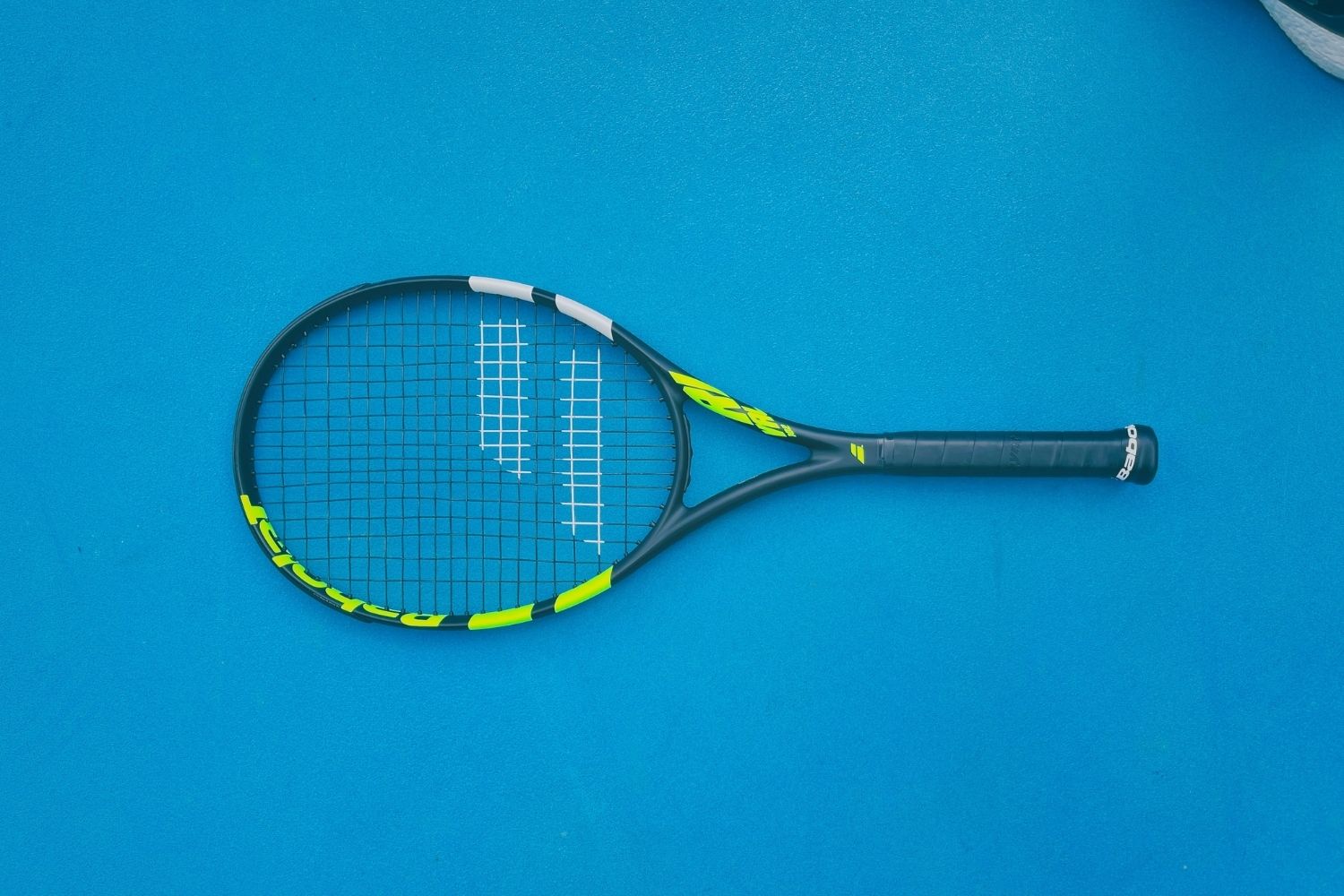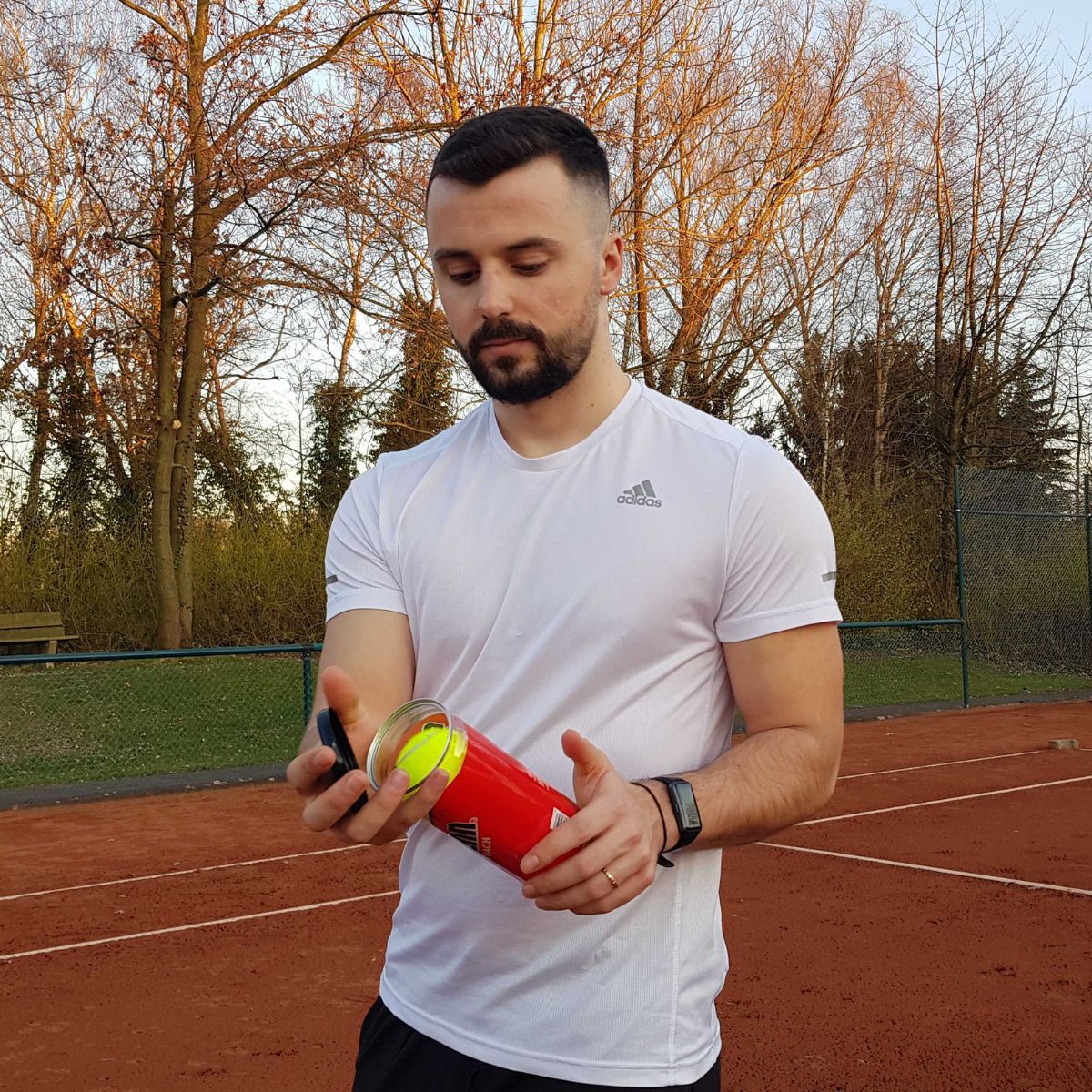- Weight and balance are two of the most important elements to consider when purchasing a new tennis racket.
- There are three types of tennis rackets based on weight measurements: lightweight, midweight, and heavy.
- Balance is how weight is distributed in the racket’s body, and rackets fall into one of three categories: balanced, head-heavy, or head-light.
When purchasing a new tennis racket, weight and balance are two of the most important elements to consider. These measurements are critical to telling the main features of the racket before deciding which one will suit, at best, your abilities and skills.
However, these can be tricky to understand, especially if you are a beginner and just can’t wrap your head around these things. That’s why, in this guide I will give you clear explanations of tennis racket weight and balance, helping you to get across the main things you should know when choosing a tennis racket. This will help you to understand how these measurements impact your tennis racket and your performance in the court as well.
Tennis Rackets Weight
Make no mistake. The weight of your tennis racket will impact your connection with it and how you’ll perform on the court. Before picking up a new tennis racket, it’s important to consider the weight as one of the most critical specifications.
Based on their weight measurements, there are three types of tennis rackets.
Lightweight Rackets
Lightweight rackets are versatile and easy to maneuver. Usually, they weigh 10.5 oz or less, come in bigger head sizes, and have a stiffer frame. With these rackets is very easy to generate high levels of power, but they lack stability and offer limited control.
A lightweight racket is the best tennis racket for beginners or recreational players. They can also be a great fit for athletes with a small physiques.
Midweight Rackets
Standing in the middle of the weight range, these tennis rackets are the golden mean between power and control rackets. They have a good blend of both power and control. Also, such rackets are well-balanced and easy to maneuver.
Usually, their length is the standard 27 inches, which provides enough leverage, stability, and comfort. Typically, these rackets weigh anywhere from 10.5oz to 11.5oz. Midweight rackets are a great fit for players of all skill-level, particularly those who stand at intermediate levels.
Heavy Rackets
Usually, heavy rackets weigh 11.5 oz or more, come in smaller head sizes, and have flexible frames. They offer a great level of control and stability, allowing the player to hit full, powerful swings.
Since heavy rackets are precise, it’s easy to predict where the ball will go.
These rackets can absorb vibrations and reduce shock, making them very comfortable for the arm. However, these rackets lack power and aren’t easy to maneuver, so the player should have the physical abilities to generate their strength during the shots.
Tennis Racket Weight Chart
As you can already tell, tennis racket weight impacts the racket’s performance. That’s why you should always look up to the technical specifications because that’s how you can tell if a racket suits your skill levels or not.
To wrap it up, here is the tennis racket weight chart, which can help you navigate faster and better while choosing your racket in a market filled with so many different models and designs.
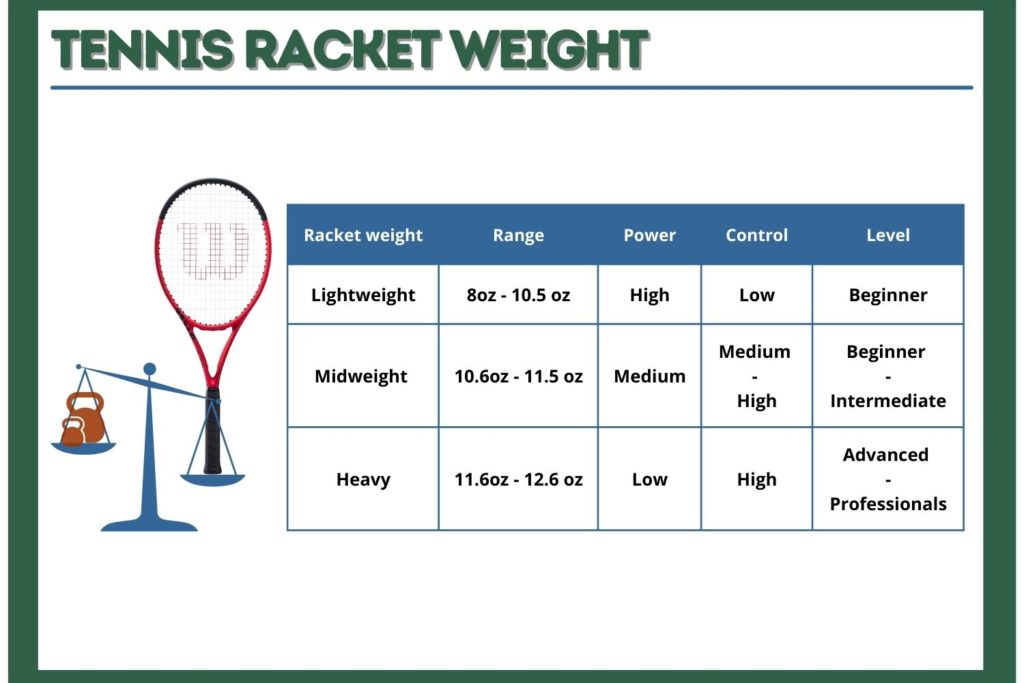
Tennis Racket Balance
The tennis racket balance is another factor that you should consider before choosing your tennis racket. I know it might seem like too much information at once if you are a beginner, but I promise you it’s not as complicated. Here I will break down all you need to know about the racket’s balance and how it is related to its weight.
First things first, what does balance signify in a tennis racket?
Balance is simply the way how weight is distributed in the racket’s body. Based on this factor, tennis rackets are divided into three categories, as listed below.
Balanced
A balanced racket has its weight evenly distributed throughout the head and the grip. Typically, such a racket would score 13 to 15 points on the balance chart. They come in a standard size of 27 inches and classifies as midweight rackets.
The midsize head can produce a satisfying level of power, while the standard-length grip offers stability and a nice feeling of control.
Head Heavy
The weight of the head-heavy racket is distributed mostly toward the head. Head-heavy tennis rackets generate high levels of power, which the player can easily tap into. They are an optimal choice for players who don’t have the physical ability to generate power or are still learning the technical aspects of the game.
A heavy head allows a good level of maneuverability and makes it easier to switch the grip since they are lightweight. These rackets don’t have much control, but this is a feature that beginners won’t need much, anyway. However, they do have a decent level of stability, which prevents the racket from twisting.
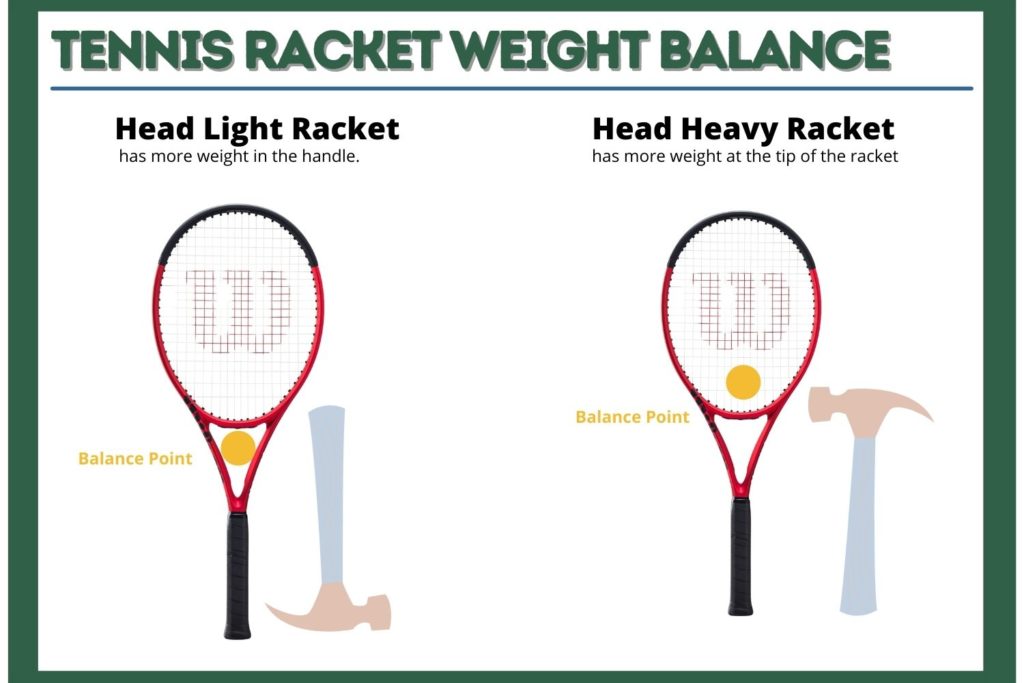
Head Light
The weight of a headlight racket is distributed mostly toward the handle. Such rackets are very easy to maneuver and allow the player to have a great sense of control over the ball. They are also highly stable and are a great fit for aggressive players who aim for fast, powerful swings.
Usually, light head rackets are the first choice of advanced and professional players. These rackets also can absorb shock and vibrations, making them more comfortable for the arm.
However, they are on the heavier side of the spectrum, so the player should have the physical strength, or with time it can cause discomfort with the wrist. Light head rackets don’t generate a lot of power, either. That’s why the player must be able to generate power and spin on its own.
Tennis Racket Balance Chart
To wrap it up, the tennis racket balance chart will make it easier to remember the main differences between light heads, heavy heads, and balanced tennis rackets. You can keep this chart as a reference whenever your need to compare the measurements of a racket.
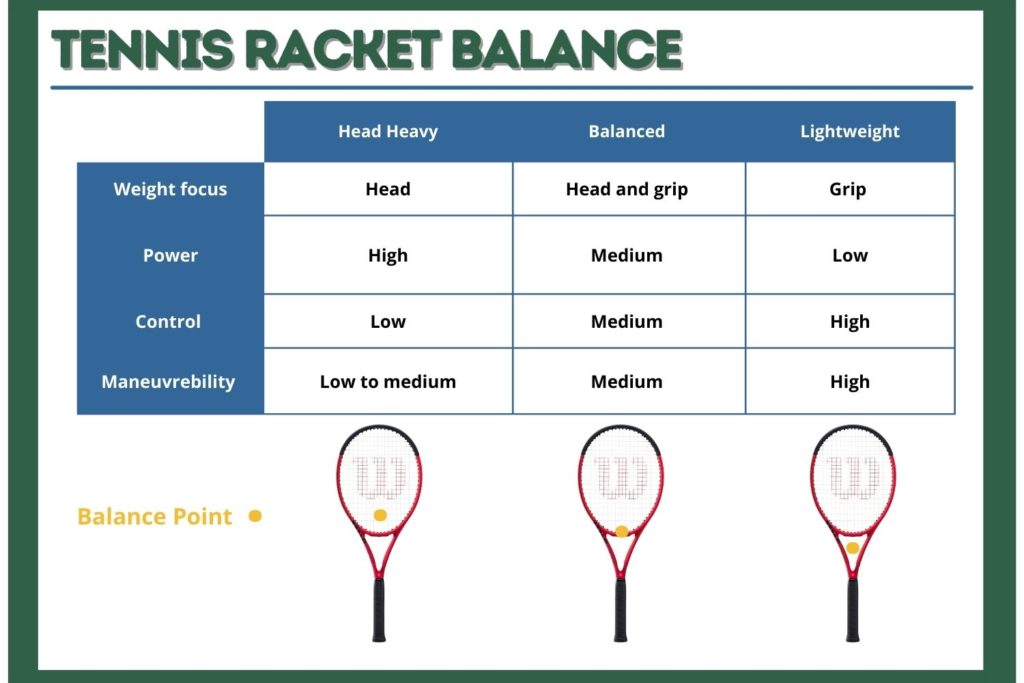
How to Measure a Racket’s Balance
In case you are wondering if you can measure a racket’s balance on your own, the answer is yes. Here is how you can do it on your own.
The technique is pretty simple, and it requires simple logic. Keep in mind that the “balance” numbers show the point of gravity or the location where the heaviest weight is. Balance is always measured horizontally or lengthwise.
The measurements start from 0, at the bottom of the racket’s grip, and increase with ½ for every inch increments.
A standard 27 inches racket with a 14-number balance is considered a well-balanced racket. You can always refer to the weight and balance chart for a better understatement when doing the measurements.
Another popular way to determine the balance point of a racket is by using a balance board scale. If you have or buy one of those, you can measure the balance in four easy steps.
- At the center of the scale, the board places the tennis racket. Always making sure that the handle is pointed toward the ruler or scale.
- With slow motions, rotate the bar on the left until the head drops at the table or the surface on you have placed it.
- Once again, make sure to rotate the handle in the opposite direction until the handle drops over the scale. This way, you will have a measurement.
- Finally, measure the distance between the racket butt and the reference mark to determine the racket’s balance.
A tennis racket classifies as head-light if the butt of the racket falls on the left side of the scale reference’s mark. If it falls to the right, then the racket classifies as a heavy-head racket.
An eighth of an inch equals one point on the balance number chart. Usually, this is the measurement most retailers use to express the racket’s balance, i.e., 14 point balance tennis racket.
Another easy way to tell the racket’s balance is by looking up the measurements, which show the distance from the racket’s butt to its handle. Most players have an easier time comparing the measurements of racket lengths instead of using the point system.
The different lengths can have the same balance point. For example, a 27 and a 29-inch racket can have both a 4-point balance, which can be confusing and doesn’t happen with a centimeter measurement.
How do You Pick a Tennis Racket Weight and Balance?
There is no ready-made formula for picking up the right racket for you with the perfect balance and weight. However, I have some helpful tips that will help you narrow down your options, especially if you are a beginner.
First and foremost, you must be honest with yourself and evaluate your skill levels. This is very important because it will help you understand your needs and what you are looking for. Keep it real with yourself, leave your ego aside, but don’t be humble, either.
To wrap it up, here are three main skill levels and what kind of rackets fits best for each category.
- Beginner – you are either just starting out or have less than a year of practicing tennis. In this phase, you need to practice your main techniques, nothing too complex. Keeping contact with the ball and perfecting your slices is the main thing that should concern you. Lightweight rackets with a heavy head balance are the perfect fit for you because you can tap into the high level of powers with ease, which will allow you to focus more on perfecting your techniques.
- Intermediate – you have played tennis for more than one year now but less than three. You feel comfortable on the court, have mastered most of the tennis techniques, and are trying to develop your own game style. Now, the precision of the ball direction and your position on the field are your main concerns. Twinner rackets that are well-balanced are the best tennis rackets for intermediate players.
- Advanced – you have been playing for a few years and feel like the racket like an extension of your arm, not just sports gear. At this level, you are focused on your game style and strategy and gaining momentum. Most likely, you are playing in competitions. Heavy rackets with headlight balance are an excellent choice for you, which will offer a great sense of control and maneuverability.
Practice, practice, practice! I know you probably hear this a lot. The more you play, the more you will understand what you like and feel comfortable playing with. With time, your preferences, game style, and skill level will change, so even if you don’t get it right the first time, it’s okay. You can switch it up.
Ask for help! Everyone starts from somewhere, so don’t be shy to ask someone more knowledgeable than you. A coach, a pro player, or a racket technician can offer some great tips and help you narrow down your options.
Since they have the experience, they can help you avoid making common mistakes. Many local shops, tennis clubs, and now even some online retailers offer demo programs where you can try different rackets before picking up one, which can be indeed helpful.
Conclusion
Tennis racket weight and balance are two very important specifications that you should always consider before choosing which one you will use on the court. You will know if you have picked the right tennis racket because it will feel just right in your hand, be comfortable, and, most importantly, help you perform better.
Hopefully, this guide will help you understand all the essential information you should know and the gap between different types to narrow down your options and make the best possible choice. You can always return to this article to refresh your memory until you feel confident enough in your knowledge of tennis rackets.
